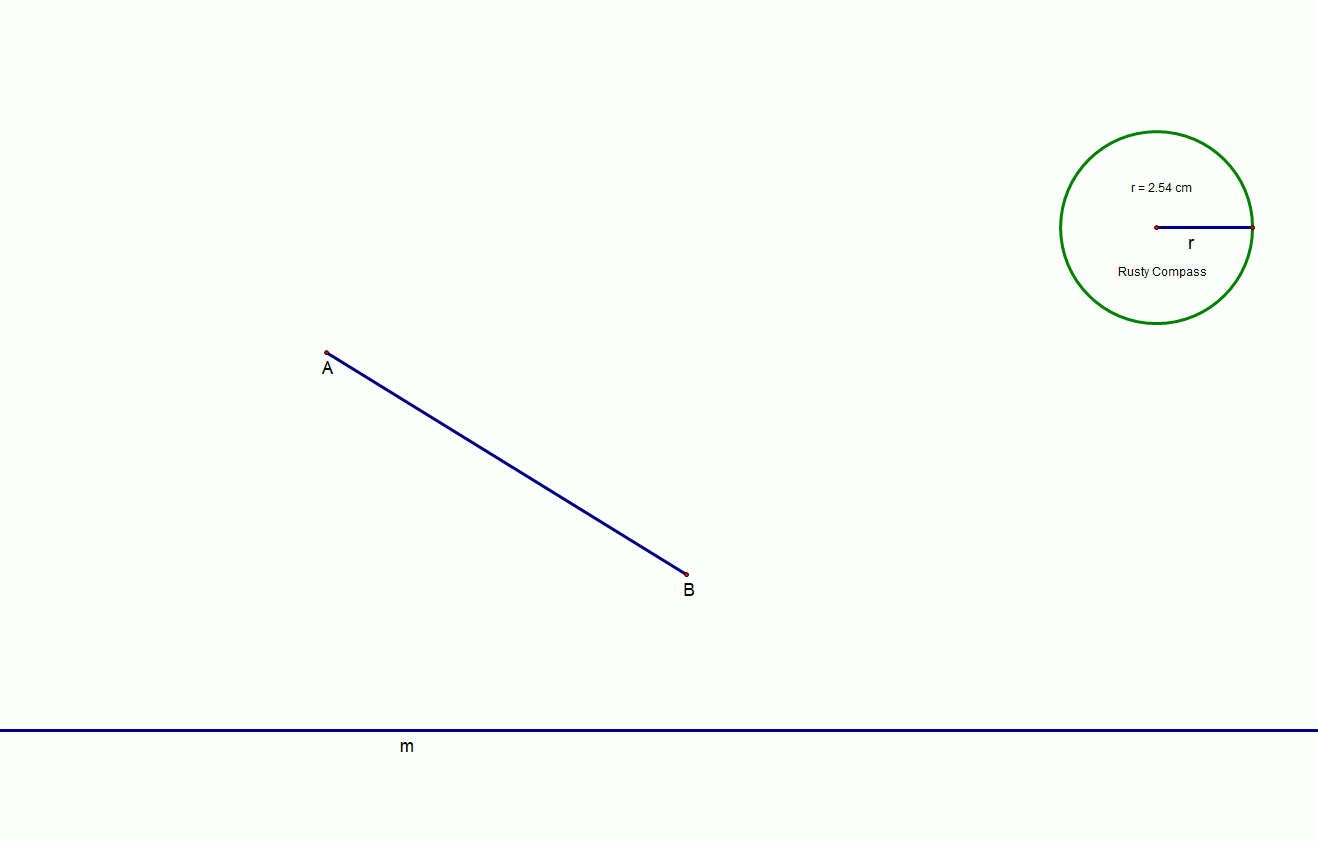A construction with ruler and rusty compass
Apologies, but I didnt like MathManiacs answer. To say the least its confusingly written, and fails to carry a construction through to the end, and makes assumptions about what is provided. Some vital details seem to be brushed over. I attempted to follow his construction and failed; I dont know why. I couldnt see what direction he was going and the instructions themselves dont make a whole lot of sense to me when you actually try to carry it out. Perhaps its my failure but I thought Id give a different perspective, filling some gaps. I of course dont mean any disrespect to the community but I didnt feel as though this 3 year old question was ever truly answered. I only came across this question in an Ask Jeeves search because I particularly love geometry.
Here is my own construction. Hopefully you can follow along with the animated GIF image. This isn't a proof; it's just a method of construction.

We have an arbitrary line m, and an arbitrary line segment AB defining the center, A, and the radius AB of a circle. No circle is drawn there because circle A(B) is of any size and you only have a rusty compass, which is defined for you in the upper-right corner. We wish to find the points of intersection on line m of where circle A(B) intersects the line.
- Segment AB can be extended to line m, intersecting it at C.
- Naturally for this construction to work line AB cannot be parallel with line m. See the notes toward the bottom for dealing with this case.
- Draw a circle A(r) centered at point A. This circle will intersect the extended line AB at some point D.
- Draw a completely arbitrary line n, passing through point A but not coincident with AB, intersecting the constant circle A(r) at point E.
- Points D and E define a new line, DE.
- Construct two new lines, parallel to DE, passing through B and C, intersecting line n at points F and G, respectively.
- Points D and F define a new line, DF.
- Construct a new line parallel to DF, but passing through G. This line intersects the extended line AB at point H.
- Draw a line parallel to line m but passing through H. This line intersects the constant circle A(r) at two points X1 and X2.
- Lines AX1 and AX2 intersect the line m at two points I1 and I2. These are your desired intersections.
If X1 and X2 dont exist then neither do the intersections I1 and I2, for obvious reasons.
I have no citation for this construction. It is based on the notion of shrinking down the scale, so that the circle A(B) becomes A(r), and line m becomes a new line that can be directly intersected with A(r) (producing the X intersections). The two I points - the intersections of interest - are projections of the two X points, away from the point A and onto the line m again at appropriate scale. Circle A(r) is to circle A(B) what the horizontal line passing through H is to the line m. The bulk of the construction is scaling line m down in proportion.
Creating a Parallel Line
To draw a parallel line using a straightedge and a single circle, the Wikipedia has an article entitled Poncelet-Steiner Theorem which contains an animated GIF depicting the construction. It requires 5 intermediary lines to be drawn for each parallel line to be made, and 1 circle (of any size) for each line from which a parallel is to be made.
The Case of Parallel AB
In the case that line segment AB is parallel to line m, a separate construction could be implemented to rotate AB into a new non-parallel position. You then restart this line-circle intersection construction using a new line segment AB'.
That said, the construction for this case is actually easier than just explained. You dont need to rotate AB at all. I wont show you the modification, but you can swap the roles of lines m and n in the original construction and adapt the construction appropriately. This can be done fairly readily and with no additional cost.
I absolutely love geometric constructions and in particular restricted constructions. Send me more. The aforementioned Poncelet-Steiner theorem, and of course the Mohr-Mascheroni Theorem, are fascinating restricted constructions in their own right.
Suppose we consider a coordinate system centred at the point $A$. Now, suppose we shrink the entire figure, keeping point $A$ fixed such that the distance between $A$ and $B$ becomes equal to $1$ inch. Hence, we can say that $B$ moves to a point $B_1$ on $AB$ such that $AB_1=1$ inch. Also, suppose that in this process, $G$ shifts to $G_1$ and $H$ shifts to $H_1$. Then, join $B_1H_1$ and $G_1H_1$.
Now, with centre $A$ draw a circle of radius $AB_1$ (which is equal to $1$ inch) that meets $G_1H_1$ at say $C_1$. Then, extend $AC_1$ to meet $GH$ at $C$ which is the required point.